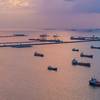WRDA Passage to End Lakes Dredging Crisis
The end of the dredging crisis on the Great Lakes moved a giant step closer today when a key House committee approved legislation requiring the federal government to spend all the tax dollars it collects for dredging on dredging rather than use nearly half to balance the budget - at least on paper.
Section 2007 of H.R. 5892, the Water Resources Development Act of 2010, mandates that all tax revenues annually deposited in the Harbor Maintenance Trust Fund (HMTF) be used to dredge the nation’s deep-draft ports and waterways. Because the government does not spend all the tax dollars it raises for dredging, the HMTF currently has a surplus of more than $5b.
The WRDA provision was derived from parallel but separate legislation advanced by Congressmen Bart Stupak (D-MI) and Charles Boustany (R-LA). Their legislation, H.R. 4844, requires that amounts credited to the HMTF are used for harbor maintenance and has nearly 50 co-sponsors. Congressman James L. Oberstar (D-MN), Chairman of the House Transportation and Infrastructure Committee, was the key player in ensuring that H.R. 4844 was included in the WRDA legislation. The Transportation and Infrastructure Committee approved the full WRDA bill, including the Stupak language on July 29.
“We are deeply indebted to Congressman Stupak, Congressman Oberstar, and others for their commitment to resolve the dredging crisis once and for all with this historic legislation,” said James H.I. Weakley, President of Great Lakes Maritime Task Force, the largest labor/management coalition ever to promote shipping on America’s Fourth Sea Coast. “Every time a vessel leaves port with its holds less than full we are denying the American economy the efficiencies for which Great Lakes shipping was designed. Even with the dredging crisis, the Corps has estimated that Great Lakes shipping annually saves its customers $3.6 billion when compared to the next least-costly mode of transportation.”
Weakley, who is also President of Lake Carriers’ Association, the trade association representing U.S.-flag vessels operators, stressed full loads would be a quantum leap in efficiency.
Although nationwide, the dredging crisis is particularly acute on the Great Lakes. Decades of inadequate funding for the Corps of Engineers’ dredging program have left 15 million cubic yards of sediment clogging the navigation system. The Corps estimates it needs $180m to clear the backlog.
The federal government has taxed cargo to fund dredging since 1987. In recent years, the Harbor Maintenance Tax has annually generated an average of more than $1.4b in revenues for the HMTF, but expenditures have averaged less than $800m.
Maintaining ports and waterways to their authorized depth is crucial for the efficiency of Great Lakes shipping. The largest U.S.-flag freighters lose 270 tons of cargo for each inch of reduced draft. As July ends, vessels designed to carry approximately 70,000 tons of iron ore or coal each trip are loading only about 65,000 tons because of the dredging crisis and falling water levels.
Another GLMTF officer labeled the dredging crisis a jobs killer. “It takes 1.5 tons of iron ore, 400 pounds of fluxstone, and a quantity of met coal to make a ton of steel,” said John D. Baker, 1st Vice President of GLMTF, and President Emeritus of the ILA’s Great Lakes District Council. “The dredging crisis is jeopardizing hundreds of thousands of family-sustaining jobs in our steel mills, our iron ore and coal mines, our limestone quarries and factories throughout the nation. The rebound in steel production has put many men and women back to work. An end to the dredging crisis can only result in more industrial activity and the jobs that would create.”
Legislation to require the HMTF to spend what it takes in each year is also moving forward in the Senate. S. 3213, introduced by Senator Carl Levin (D-MI), has 15 co-sponsors.










